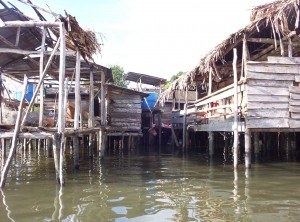August 26, 2011
In spite of relevant political initiatives, notably the Victims and Land Restoration Law fostered by new President Juan Manuel Santos, humanitarian needs in Colombia are still acute. The deteriorating security situation since 2008, following a period of intense military offensive in zones traditionally out of the control of the Colombian authorities, is now challenging the new Government. The FARC has changed its strategy from territory-control to guerrilla warfare, intensifying use of mines and snipers, while the heirs of former paramilitary groups continue their criminal activities with a different denomination.
 Persisting humanitarian needs heightened by 2010 floods
Persisting humanitarian needs heightened by 2010 floods
The official IDP figure remains extremely high -3.700.381 people- in a country where under-registration is still unresolved. Massive forced displacements increased, although individual displacement continues to be much more frequent. Humanitarian needs are especially dire in rural areas, where confined populations have very limited access to basic services, like health or education, income generation activities or even humanitarian assistance.
In 2010 the most intense rains in Colombia’s history led to floods all over the country, severely affecting over 2 million people. Colombian authorities responded effectively at a first stage, thanks to previous experience in disasters, such as the 1999 earthquake, but were soon outweighed by the magnitude of the disaster. The need for new land planning, a reinforced and integrated disaster risk reduction system, and the improvement of local response capacities cannot be postponed, experience so far shows that climate change challenges are no longer apocalyptical prophecies, but real facts.
Humanitarian challenges in a middle income country
While this new Government has recently recognized the existence of an armed conflict (longtime neglected by the former administration), looking at both the IDP and flood crises, public institutions pay very different attention to each one. Some organisations estimate that 1 out of 4 floods-affected people were IDPs which, in fact, shows that new emergencies are affecting old victims. Thus, inequity and lack of an effective state presence and investment remain the root causes of the humanitarian crises in Colombia.
The new Colombian Government’s attitude towards the conflict and the victims opens the door to a more principled and effective response. While respect for neutrality and impartiality of humanitarian aid and effective protection of civilians are still necessary, the international community currently faces the challenge to develop new approaches in a middle income country. The UN system faces the need to become exigent and efficient, whilst remaining a key actor in Colombia.
Facing recurrent natural disasters and new scenarios and actors in the same old armed conflict, humanitarian actors -especially donors- are required to adopt a mid or long term perspective of the humanitarian crises in Colombia to sustain the necessary assistance to the –still- second largest IDP crisis in the world.
Share this